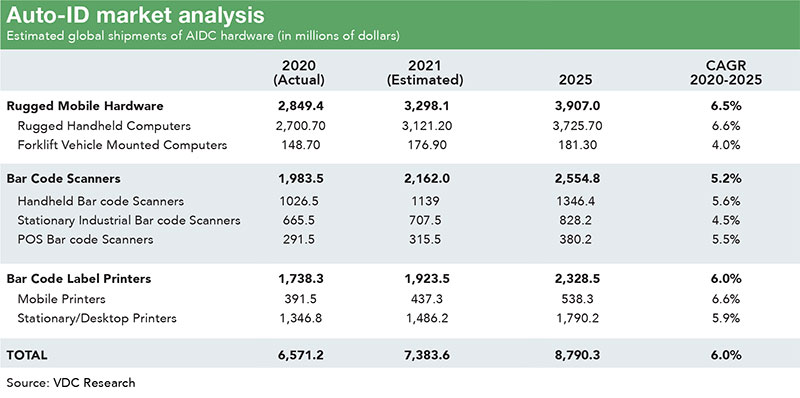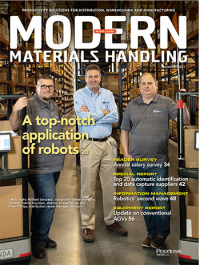Top 20 Automatic Identification and Data Capture Suppliers 2021
With supply chains in disarray and the labor shortage persisting, companies across the board are turning to automatic identification and data capture (AIDC) solutions to help them work smarter, better and faster.
A group of technologies that identify, track, record, store and communicate essential data, automatic identification and data capture (AIDC) solutions are playing an increasingly important role in today’s warehouse and distribution center operations. Within the four walls of these busy facilities, AIDC solutions—also known as Auto-ID—facilitate the gathering, manipulation and sharing of data with voice, keypads, touchscreens or other mechanisms.
According to AIM North America, an alliance of automatic data capture providers, AIDC technologies serve as the front end of enterprise software systems, where they provide fast and accurate collection and entry of data. In fulfillment centers, multiple AIDC technologies are often combined to create a single, enterprise-wide solution. The actual solutions include (but aren’t limited to) bar codes, biometrics, RFID, machine vision, real-time locating systems, voice and optical character recognition.
As they work to contain the ongoing impacts of the global pandemic and persistent labor shortage, warehouse operations are increasingly turning to technology to help them work better, smarter and faster. For many operations, this has meant investing in new tools, equipment and applications that help workforces get more done within a compressed amount of time and as safely as possible.
Standing by to answer this call and help customers meet those goals, this year’s AIDC Top 20 suppliers make the handheld rugged mobile computers; vehicle-mounted computers; handheld and stationary bar code scanners and thermal label printers that are being used in warehouses and DCs worldwide. Prepared by VDC Research, the list does not include RFID, rugged tablets, wearable computers or printer consumables, accessories and services.
By the numbers
In 2020, many of the companies claiming the top spots on the list saw their related revenues drop, presumably due to the pandemic impacts. No. 1 Zebra Technologies, No. 2 Honeywell (which includes LXE, Intermec and Datamax-O’Neil), No. 3 Datalogic and No. 4 SATO all experienced year-over-year revenue losses ranging from 0.6% to 19.9%. Across the complete list, seven of the 20 companies experienced AIDC-related revenue gains in 2020.
A new entrant into the “Top 5” club, SICK AG experienced a robust bump of 24.3% in its AIDC revenues in 2020. This put SICK in the 5th spot on the list, having moved up from a previous ranking of 11 in 2019. Rounding out this year’s top 10 were Cognex (which saw its revenues increase by 9.1%), Toshiba TEC, Fujian Newland, Denso Wave and TSC Printers (all of which experienced year-over-year declines).
Cumulatively, the AIDC Top 20 posted a 3.2% revenue decrease from $5.75 billion in 2019 to $5.56 billion in 2020. Factoring prior year’s combined revenues—which have been growing consistently since at least 2016—the global pandemic was the likely cause of the substantial decrease in overall AIDC sales in 2020.
|
2021 Rank |
2020 Rank |
Company Name |
2020 Revenues (USD, in millions) |
2019 Revenues (USD, in millions) |
Year over Year |
North American Headquarters |
Bar code printers |
Handheld scanners |
Stationary scanners |
RFID |
Mobile computers |
|
1 |
1 |
2588.3 |
2603.3 |
-0.6% |
Schaumburg, Ill. |
X |
X |
X |
X |
X |
|
|
2 |
2 |
759.0 |
798.4 |
-4.9% |
Morristown, N.J. |
X |
X |
X |
X |
X |
|
|
3 |
3 |
466.3 |
582.4 |
-19.9% |
Eugene, Ore. |
X |
X |
X |
X |
||
|
4 |
4 |
250.6 |
264.5 |
-5.3% |
Charlotte, N.C. |
X |
X |
||||
|
5 |
11 |
175.0 |
140.8 |
24.3% |
Minneapolis, Minn. |
X |
X |
||||
|
6 |
5 |
162.7 |
149.1 |
9.1% |
Natick, Mass. |
X |
X |
||||
|
7 |
6 |
152.0 |
174.3 |
-12.8% |
Irvine, Calif. |
X |
X |
||||
|
8 |
10 |
135.9 |
154.5 |
-12.0% |
Fremont, Calif. |
X |
X |
X |
X |
||
|
9 |
7 |
130.4 |
134.5 |
-3.0% |
Southfield, Mich. |
X |
X |
||||
|
10 |
9 |
109.7 |
116.7 |
-6.0% |
Pomona, Calif. |
X |
|||||
|
11 |
14 |
101.5 |
104.1 |
-2.5% |
Itasca, Ill. |
X |
X |
X |
X |
||
|
12 |
13 |
85.2 |
83.9 |
1.5% |
Shandong, China |
X |
X |
||||
|
13 |
18 |
81.5 |
97.2 |
-16.2% |
Newark, N.J. |
X |
|||||
|
14 |
15 |
69.2 |
68.0 |
1.8% |
Palisades Park, N.J. |
X |
X |
||||
|
15 |
16 |
57.3 |
55.4 |
3.4% |
Los Angeles, Calif. |
X |
X |
X |
|||
|
16 |
n/a |
49.4 |
32.3 |
52.9% |
Guangdong, China |
X |
X |
X |
|||
|
17 |
18 |
48.8 |
48.5 |
0.6% |
Glendale, Calif. |
X |
X |
||||
|
18 |
17 |
47.9 |
52.8 |
-9.3% |
Wiesbaden, Germany |
X |
|||||
|
19 |
19 |
47.2 |
47.5 |
-0.6% |
Tyngsboro, Mass. |
X |
|||||
|
20 |
n/a |
44.0 |
40.2 |
9.5% |
Seoul, Korea |
X |
X |
X |
|||
|
TOTAL |
5561.9 |
5748.4 |
-3.2% |
||||||||
Assessing market performance
Looking at the AIDC equipment sector’s performance over the last year, David Krebs, VDC Research’s executive vice president of enterprise mobility and the connected worker, says he saw several trends more pronounced and accelerated in 2020.
This was especially true in the retail sector with the massive shift—or step change—to e-commerce and omni-channel shopping. This pivot isn’t expected to wane, with eMarketer predicting that online sales will comprise 23.6% of total retail sales by 2025 (vs. 11% in 2019).
“While some retailers and brand owners were better prepared for the e-commerce boom, others were forced to adjust and pivot almost on the fly,” says Krebs. “One of the key takeaways over the past 18 months was the premium of operational visibility (e.g., inventory, assets, people, etc.) and the value of AIDC solutions in creating that real-time visibility.”
In reviewing the AIDC Top 20 for 2020, Krebs says that when the pandemic first emerged in March 2020, there was much uncertainty in the outlook for the rest of the year, with expectations that we would see contraction of 20% to 25%—similar to that of the Great Recession one decade ago. And while the early stages of the pandemic proved disruptive for many organizations, the double-digit contraction never happened.
“What ended up happening was a much more resilient second half of 2020 and what has been an explosive 2021, with double-digit growth across all AIDC product categories,” says Krebs, who adds that the sector is poised for more growth in the coming months, despite the fact that it cumulatively saw its revenues retreat by 3.2% in 2020.
“Looking to 2022 and beyond, the growth fundamentals remain strong,” Krebs points out. “And while we don’t expect double-digit growth for AIDC on an annual basis, we’re seeing resurgent demand among organizations looking to modernize existing solutions or new users.”
According to Krebs, this will differ from what we saw in 2020, when much of the AIDC investment involved larger/Tier 2 organizations that were looking for new tools, equipment and applications to help them run their supply chains.

“What we are seeing in 2021 is the return of the ‘run-rate’ business and demand from mid-market organizations,” Krebs says. Some of this demand is being tempered by the ongoing pandemic and the resultant supply chain shortages, port congestion and labor constraints, all of which are having a direct impact on equipment lead times.
“Even with the strong demand drivers in place, a critical challenge for all vendors has been fulfillment due to challenges with sourcing materials and components,” Krebs adds. “Turnaround time for hardware can be eight to 12 weeks out, if not longer.”
Resistance to change
At the recent Modern Materials Handling “2021 Virtual Summit:
Gearing up for growth,” Krebs discussed the maturity of mobile technology solutions, noting that an unexpected byproduct of the pandemic was the acceleration of key digital transformation efforts. With the labor shortage in full swing, he says equipping workers with the necessary tools becomes more important than ever.
Knowing this, many companies right now are focused on speeding up their fulfillment processes, improving storage capacities (as order volumes increase), and improving perfect order rates, according to a recent VDC survey.
Collecting the data
This is our 19th-annual look at the leading manufacturers of automatic data capture hardware and solutions. Because the industry includes public and private companies, this is the 13th year that VDC Research Group compiled our data.
Because they are covering this technology every day, they are closer to the market. To make our list, companies must sell in North America, though the chart includes worldwide revenues. We do not include resellers, systems integrators or other companies that do not manufacture ADC hardware.
Because our readers are primarily focused on supply chain solutions, we do not include companies whose primary focus is the retail checkout counter or non-industrial settings, like hospitals, libraries or resorts. Nor do we include companies that only manufacture consumables like bar code labels and RFID tags.
“Obviously, Covid-19 has highlighted the need for strong technology solutions to support logistics and fulfillment,” says Krebs, “and particularly in terms of customer expectations, labor challenges and warehouse technology trends.”
When it comes to technology, however, the warehouse has typically been more risk averse. “These operations mainly look at how to cut costs, as opposed to looking at it as a profit center,” Krebs says. “It’s a challenge for them to justify new solutions.”
This risk aversion has created pitfalls for organizations, especially when it comes to onboarding new and retaining existing employees. “Resistance to change is proving to be a key barrier to overcome among warehouse decision makers,” Krebs says. “Other obstacles to implementing warehouse technologies include cost of technology, security concerns and project complexity.”
Managing in the new abnormal
Despite the longer lead times for equipment and pandemic-driven supply chain disruptions, more companies want to put AIDC equipment into their warehouses and DCs to gain efficiencies, improve throughput and more effectively manage the “new abnormal” operating environment. In assessing current AIDC technology usage and adoption rates, Krebs says the majority of demand is being generated by the “usual segments,” which include warehouse and retail operations, last-mile delivery and overall logistics.
Digging down into the specific industries that are investing in and using AIDC equipment, Krebs says VDC has seen more interest from the healthcare sector as it works to support Covid-19 testing. He’s also seeing renewed emphasis on and demand for traceability solutions, and particularly within the food, pharmaceutical and automotive sectors.
As for the technology itself, Krebs has been tracking a transition to camera-based scanning solutions over the last few years, and says these solutions can scan and decode more data-rich data carriers like DataMatrix (a matrix 2D code developed in 1987). “This is opening the door to more uniquely identify items with lot and date codes, expiration, manufacture origin and so forth,” he points out.
As the pandemic persists and supply disruptions continue, AIDC solutions will continue to play a role in helping companies address their current challenges while preparing for future growth. For most, this means making the most efficient use of infrastructure and assets that are already in play.
“Supply chains are in disarray and will likely remain so heading into 2022. The labor shortage is a massive issue in areas like warehouse and delivery operations,” Krebs says. “While this is opening the door and leading to greater investments in automation, labor obviously remains critical. Therefore, ensuring labor optimization is even more important than ever.”

Article Topics
Data Capture News & Resources
NetLogistik partners with Vuzix subsidiary Moviynt to offer mobility solutions for warehouses AI-based inventory monitoring solution provider Gather AI raises $17 million ProGlove and topsystem partner on hands-free picking solution JLT Mobile Computers launches warehouse productivity software Zebra Technologies introduces wearable computers Peak Technologies exhibits machine vision solutions The reBound Podcast: Innovation in the 3PL supply chain More Data CaptureLatest in Materials Handling
Registration open for Pack Expo International 2024 Walmart chooses Swisslog AS/RS and software for third milk processing facility NetLogistik partners with Vuzix subsidiary Moviynt to offer mobility solutions for warehouses Materials Handling Robotics: The new world of heterogeneous robotic integration BSLBATT is looking for new distributors and resellers worldwide Lucas Watson appointed CSO for Körber’s Parcel Logistics business in North America Hyster recognizes Dealers of Distinction for 2023 More Materials HandlingAbout the Author
Subscribe to Materials Handling Magazine

Find out what the world's most innovative companies are doing to improve productivity in their plants and distribution centers.
Start your FREE subscription today.
April 2024 Modern Materials Handling

Latest Resources












